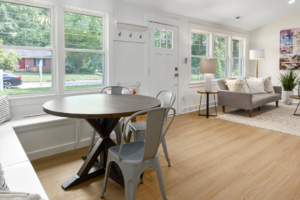
Want to know a big secret about being organized during a life-disrupting situation?
Are you sure?
It’s all about FLOW.
Let me explain. The word “flow” implies continuous movement, such as “the river flows into the ocean.” While we’ve gotten really proficient at stuff flowing in, we aren’t as accomplished at stuff flowing out!
It’s time to Find Your FLOW!
EXAMPLES:
- Dresser drawer full of t-shirts. You buy four more at a sale. Do you jam them in the drawer? Leave some on a chair or the floor? Delete four of your current t-shirts to make room for the new ones?
- Bookshelf packed with outdated training and conference materials. While most new information is in digital format, periodically you get a new book. Do you put the book on the floor? Do you move some of the training documents to the floor and place the book in the bookcase? Do you delete the obsolete information, put the book on the shelf, and have room left over for more in the future?
In each example, you have a choice.
- Keep adding stuff and experience overwhelm.
- Delete (donate, consign, recycle, etc.) a similar number of items as you add them.
There is a third option: decide you’ll take action at a later time. Unfortunately, this “later time” often becomes “never.”

There are additional concepts necessary to create FLOW. I’ve put them altogether in my Flexible Structure Method, which I’m not going to go into depth right now. Instead, I’ll use the example of an excess of personal or professional papers as an illustration. And if you don’t have a problem corralling your papers, think of something else: shoes, books, etc.
You chose a file cabinet for your papers. You decided that all papers must fit in this file cabinet (BOUNDARY). You noticed that it’s harder to get some papers into their drawers.
Despite your best attempt to use electronic documents as much as possible, you know that you’ll always have some paper. So you have a CHOICE: maintain the current BOUNDARY and implement FLOW to delete some of your papers (shred, recycle, digitize) OR enlarge your BOUNDARY and buy another file cabinet. Of course, the alternative is to let the papers spill onto other surfaces and the floor. If you feel overwhelmed in this scenario, it would be a good time to practice MINDFULNESS, which is one of my Beacon Habits, before you make your decision.
Why am I bringing this up when I’m usually talking about organizing or productivity as it relates to a life-disrupting situation? Because it’s easier to establish FLOW before a life transition. Plus, since I’m writing this during COVID, we’re all going through a big upheaval to our lifestyle, so now’s as good a time as any to discuss FLOW ?
Your turn! Choose to experiment with FLOW over the next month.
- Where you do feel the most inundated by your stuff? Let’s say it’s your kitchen.
- What is most overwhelming about this room? For this example, it’s the inability to find canned food and dry-goods in the pantry and cabinets.
- Decide your method of creating FLOW.
- Use it up before you buy more. For one or two meals each week, use the canned goods in your pantry. You can only purchase fresh food at the store.
- One in-one out expectation. For every new item you bring in, you have to delete one item. You can delete it by donating, using, or throwing it away.
- Declutter in small sections. Designate a little time every few days to clear one shelf.
- You can use a combination of these methods or create one that works for you.
If you’re willing to try this FLOW experiment, let me know your “where you feel most inundated by your stuff” in the comments below. I’d love to cheer you on!
Tag:ADHD, anxiety, autoimmune disease, Beacon Habits, brain based disorders, covid, COVID-19, depression, Find Your Flow, Flexible Structure Method, life transitions, Life Transitions Organizing, Life Transitions Resources, life-disrupting situation, organizing, Productivity, productivity and organizing professional, professional organizer, TBI, Transition Success Program


